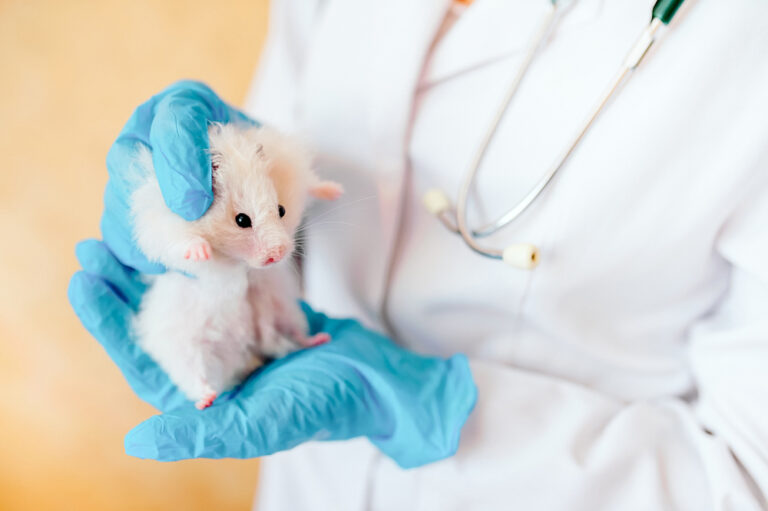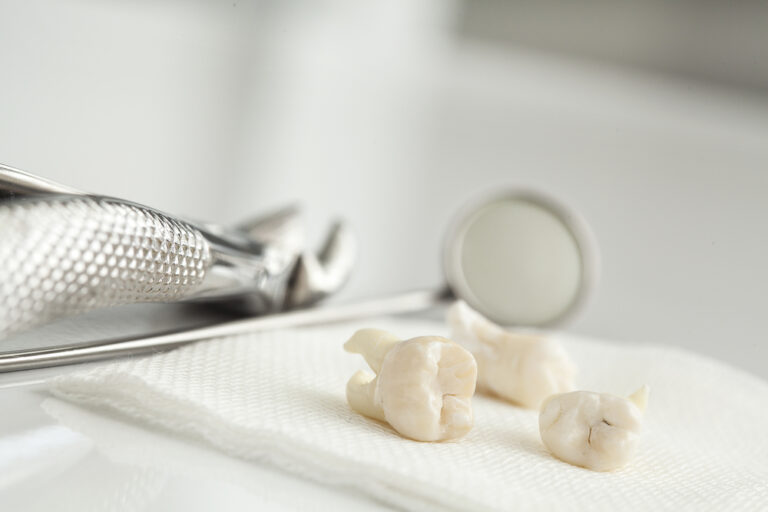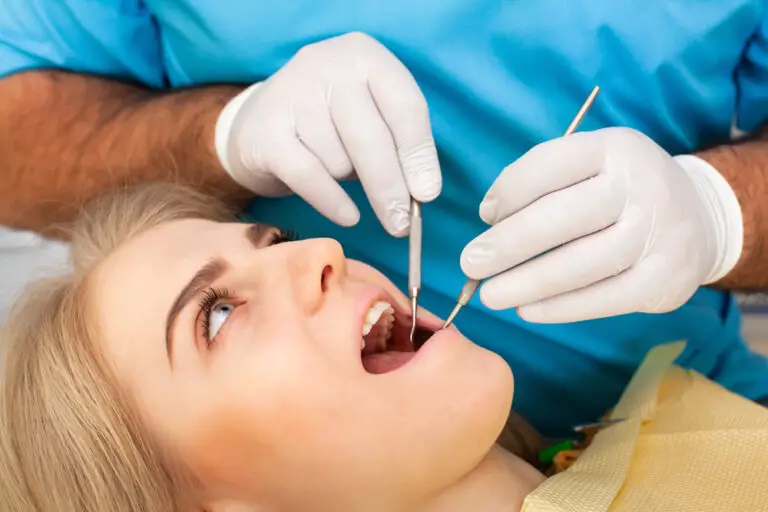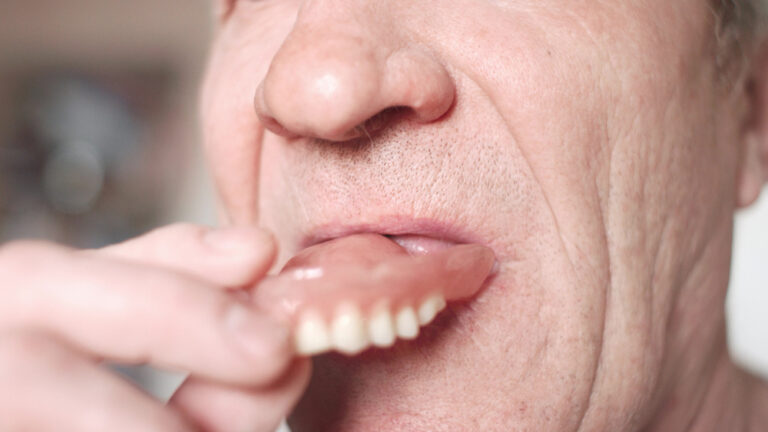The two front teeth, known in dental terminology as the maxillary central incisors, have the largest size of any teeth in the mouth. Their unique enlarged dimensions serve important functions related to biting, tearing, speech, and esthetics. This article will take an in-depth look at the anatomy, purpose, development, problems, and care for the two front teeth to understand the reasons for their relatively giant size.
Detailed Anatomy of the Front Teeth
The central incisors have distinct anatomical structures that enable their increased proportions compared to other teeth.
Crown
- The visible part of the tooth above the gumline is called the crown.
- It is covered by shiny white enamel, which is the hardest substance in the body.
- The broad crowns of the central maxillary incisors have a shovel-like shape with rounded edges.
- Their wider surface area and thicker enamel layer provides exceptional strength for biting off and tearing food.
- The average mesiodistal width of the crowns is 8.5 mm and labiolingual width is 8.0 mm, which is greater than any other tooth type.
- The curvatures of the crown help the tooth resist forces during biting and chewing.
Root
- The root anchors the tooth into the upper jaw bone.
- The maxillary central incisors have a single conical shaped root.
- The root is quite long, averaging 16 mm in length.
- This is substantially longer than molars which average around 12 mm.
- The considerable length provides a sturdy foundation for the oversized crown.
- The root diameter is broadest at the cervical line near the crown and tapers apically.
- This shape allows adequate surface for the periodontal ligament fibers to attach and support the tooth’s position.
Pulp
- The pulp chamber and root canal make up the innermost hollow part at the center of the tooth.
- It contains nerves, lymphatic vessels, connective tissue, and blood supply.
- To sustain the enlarged tooth size, the front teeth have an abundant pulp volume.
- The pulp horns extend higher into the crown to nourish the thicker dentin.
- Greater capacity means the pulp is less prone to inflammation and necrosis when decay reaches it.
Dentin
- Dentin comprises most of the tooth’s bulk and encases the pulp.
- This bone-like tissue is yellow and softer than enamel but harder than bone.
- The front teeth have a greater volume of dentin proportional to their size.
- The extensive dentin accounts for the majority of the increased tooth dimensions.
Periodontal Ligament
- The PDL joins the cementum covering the root to the alveolar bone socket.
- It contains collagen fibers that anchor and support the tooth’s position.
- The front teeth have an expanded PDL attachment surface area due to the larger root size.
- This provides the periodontal support needed for the heavy biting forces exerted.
This combination of anatomical features enables the front teeth to grow to significantly enlarged dimensions.
Functions of the Front Teeth
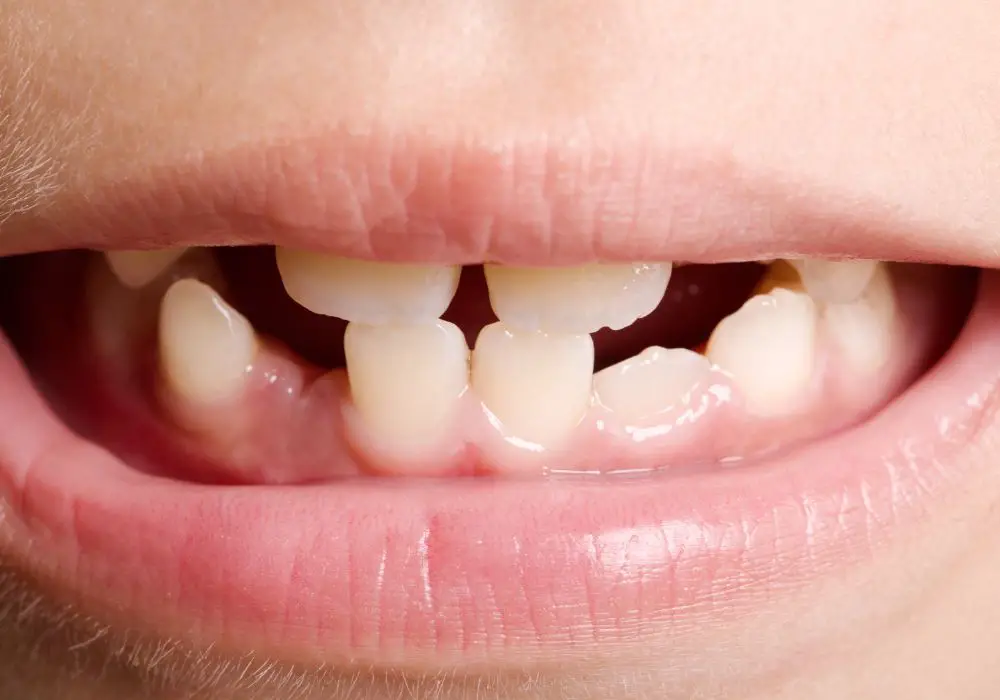
The large size of the central incisors is directly linked to their specialized functions. The key roles include:
Biting and Tearing
The broad biting edges and thick enamel of the front teeth make them ideally suited for biting off and tearing pieces of food. Their sturdy structure withstands the significant forces involved in these actions. This function is critical in starting the mechanical digestion process.
Speech
The front teeth play a crucial role in speech and pronunciation. Their position gives them prominence during speaking. The way the tongue strikes these teeth helps create certain sounds like “f” and “v”.
Esthetics
As the most visible teeth, central incisors greatly influence the esthetic appeal of one’s smile and face. Their size, shape, and position provide balance and symmetry.
Due to these vital functions, the front teeth require their unique large dimensions.
Evolutionary Purpose of Enlarged Front Teeth
Several theories explain how evolutionary pressures gave rise to the increased size of human front teeth. Here are some of the leading ideas:
Dietary Adaptation
Anthropologists believe the larger front teeth evolved to help early humans bite off and chew fibrous vegetation and unprocessed foods. This adaptation was needed to consume tougher diets as hunting and gathering replaced the more easily digestible softer foods consumed by human ancestors.
Tool Use
The use of tools by early humans is thought to have contributed to larger front teeth. The teeth were needed for functions like gripping, tearing, and clamping items. Their prominence and strength made them suitable for these purposes before specialized tools were developed.
Sexual Selection
Similar to other gender differences, the larger male front teeth are believed to have arisen through sexual selection. More imposing front teeth may have provided advantages in competing for mates.
While the exact evolutionary pressures are debated, most agree the functions of the front teeth necessitated their enlarged size compared to other teeth.
Development of the Front Teeth
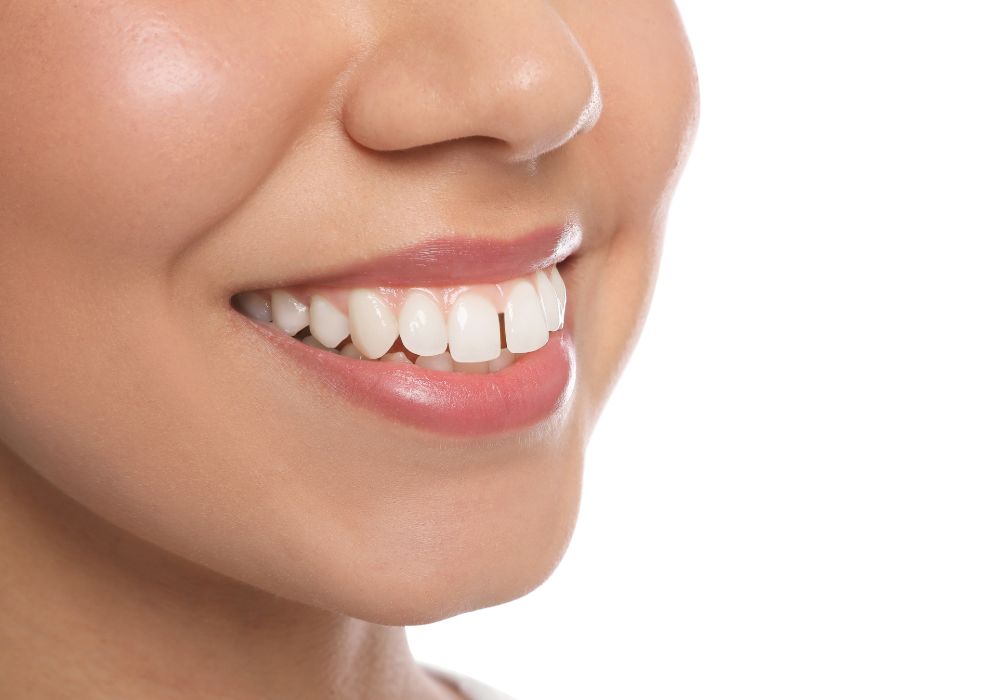
The increased growth of the front teeth occurs during two main developmental stages:
In Utero
Initial enlargement of the front tooth buds happens during fetal development in the womb. The deciduous or baby front teeth form earlier and grow bigger than posterior teeth.
Childhood
The permanent incisors initiate mineralization and active growth by around 6 months of age. Their full adult size is reached shortly after eruption between ages 6-8 years.
Advanced development of the front teeth in the womb and childhood is critical to attain their amplified dimensions needed for proper function.
Common Problems Affecting the Front Teeth
Due to their vulnerable protruding position, the front teeth are prone to various issues that can impair their function and appearance.
Fractures and Chipping
- Small chips in the enamel often occur due to trauma from falls, blows, or hard food.
- Larger fractures may extend deeper involving the dentin and pulp.
- Repeated stresses can initiate tiny cracks that grow over time.
Tooth Wear
- Habitual grinding or bruxism wears down the incisal edges.
- Dietary acid erosion softens and diminishes the enamel surface.
Discoloration
- Staining from foods, drinks or tobacco use can discolor the enamel.
- Internal bleaching or root canal treatment can also cause front teeth darkening.
Malposition
- Crowding, gaps, or poor alignment can occur, especially if orthodontics is needed.
- Malocclusion puts more stress on the front teeth.
Periodontal Disease
- Gum disease causes bone and attachment loss, increasing mobility.
- The broader surface area makes the front teeth more susceptible.
Prompt dental treatment is crucial to prevent minor problems from progressing into severe decay, infection or tooth loss.
Maintaining Front Tooth Health
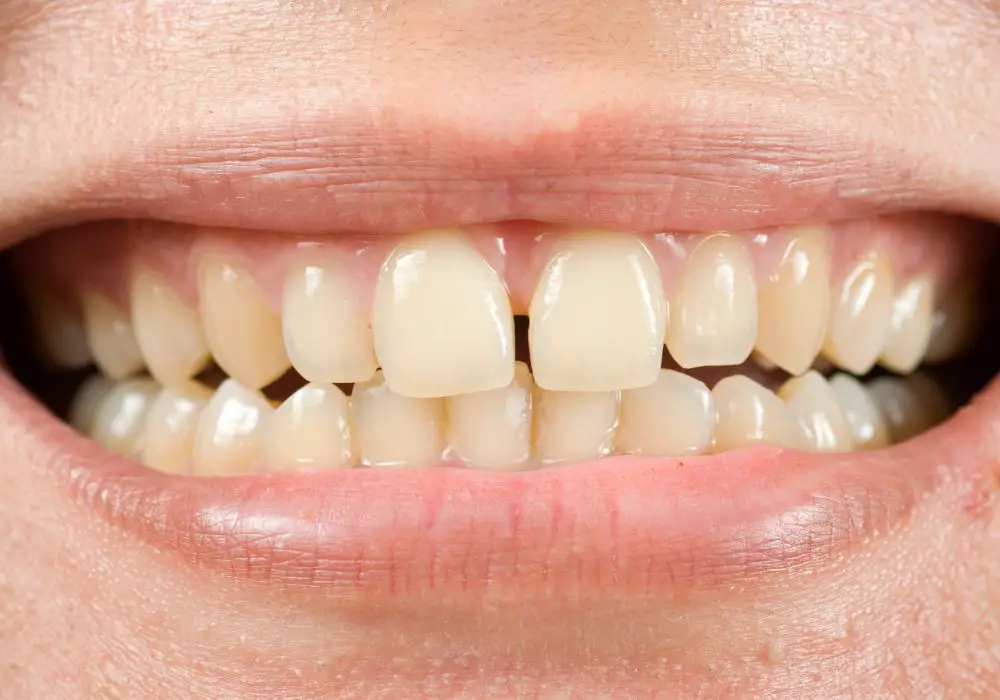
Optimal oral hygiene practices and dental care are essential to preserving front tooth structure and function.
- Brush twice daily using proper technique to clean all surfaces.
- Use a soft bristle toothbrush and fluoride toothpaste.
- Floss at least once daily to remove plaque from between front teeth.
- Avoid using teeth to open items or bite nails which can lead to chipping.
- Wear a custom mouthguard during contact sports to prevent trauma.
- Have dental fractures, chips or cracks promptly evaluated by your dentist.
- Get any cavities or tooth discoloration treated early before it worsens.
- See your dentist every 6 months for exams to identify problems early.
- Have your teeth professionally cleaned at regular hygiene visits.
- Follow any orthodontic recommendations to correct malpositioning.
Making the front teeth a priority in your oral care routine will help maintain their form and function.
Conclusions
In summary, the two maxillary central incisors are the largest teeth in the mouth for compelling reasons. Their wider crowns and longer roots provide a solid foundation needed for the forces exerted in biting, tearing, speech, and expression. Evolutionary pressures shaped their growth over time for tool use, diet, and sexual selection advantages. Their prominence also impacts facial esthetics and smile appearance. Ensuring sufficient development during fetal and childhood growth allows them to reach full mature size. Ongoing proper care and prompt treatment of any problems can help preserve your front teeth in ideal functional form. They serve critically important roles that depend on their uniquely enlarged proportions.
Frequently Asked Questions
Why are my two front teeth disproportionately bigger than the rest of my teeth?
The front incisors are intended to be significantly larger than the other teeth due to their specialized functions. Their broader size and thickness gives them the strength needed for biting off and tearing food as well as other tasks like grasping objects. Their roots are also longer to support the enlarged crown size.
Is it normal for front teeth to be longer?
Yes, having front teeth that appear visibly longer than posterior teeth is considered normal. The elongated roots provide a sturdy foundation and anchor for the broader biting surface that protrudes outward. Their forward position and biting duties necessitate this length.
What are some downsides of having large front teeth?
Oversized front teeth that are severely out of proportion can potentially create issues like:
- Impaired biting function due to misaligned occlusion.
- Higher risk of fractures or chipping due to their protruding position.
- Aesthetic concerns if excessively large, unevenly spaced or irregularly shaped.
- Speech impediments in certain cases.
How can I ensure my protruding front teeth stay healthy?
- Maintain excellent oral hygiene with proper twice daily brushing and daily flossing.
- Wear a mouthguard during contact sports or risky activities.
- Avoid using teeth to open items, bite nails or other habits that can chip teeth.
- See your dentist promptly for any fractures, pain or irregularities.
- Get routine dental cleanings and exams every 6 months.
- Follow any orthodontic recommendations.
What’s the best way to correct extremely oversized front teeth?
Consult an orthodontist who may recommend options such as enamel shaping, tooth contouring or crown reduction to conservatively recontour extremely oversized teeth. In severe cases, extraction of premolars to close space followed by orthodontic treatment may be indicated. But this also has risks, so thorough evaluation is needed.

